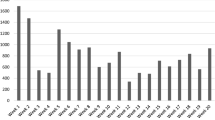Abstract
Student–instructor communication was examined in freshman biology classes taught either in traditional lecture style or by using a variety of student-centered, active learning approaches to engage students in the learning process (cooperative learning groups, wireless microphones, permanent name tags, in-class and out-of-class writing). In both classes students were encouraged to send questions, comments, and suggestions to the instructor via e-mail. In the active learning class, students also wrote in-class notes to the instructor. All messages could be classified as either content-related or procedural. More content-related messages were received in the active learning class than in the traditional class. Also, the percentage of students who sent content-related messages was much higher in the active learning class than in the traditional class. Finally, content-related messages from students in the active learning class were generally more thoughtful and insightful than those from students in the traditional class.
Similar content being viewed by others
REFERENCES
American Association for the Advancement of Science (1990). Science for all Americans, Oxford University Press, New York.
Angelo, T. A., and Cross, K. P. (1993). Classroom Assessment Techniques: A Handbook for College Faculty, 2nd ed, Jossey-Bass, San Francisco.
Collins,M. (1998). The use of e-mail and electronic bulletin boards in college-level biology. Journal of Computers in Mathematics and Science Teaching 17: 75-94.
Commeyras, M. (1995). What can we learn from students' questions? Theory into Practice 34: 101-106.
Good, T. L., Slavings, R. L., Hobson H. K., and Emerson, H. (1987). Student passivity: A study of question asking in K-12 classrooms. Sociology of Education 60: 181-199.
Harwood, W. S. (1996). The one-minute paper: A communication tool for large lecture classes. Journal of Chemical Education 73: 229-230.
Hedges, K., and Mania-Farnell, B. (1998). Using E-mail to improve communication in the introductory science classroom. Journal of College Science Teaching 28: 198-202.
Laurillard,D. (1999). Using communications and information technology effectively. In McKeachie, W. J. (Ed.), Teaching Tips: Strategies, Research, and Theory for College and University Teachers, Houghton Mifflin, New York, Chap. 17, pp. 183-200.
Marbach-Ad, G., and Sokolove P. G. (2001). Creating direct channels of communication, Journal of College Science Teaching 31: 178-182, 212.
McKeachie, W. J. (1999). Teaching Tips: Strategies, Research, and Theory for College and University Teachers, Houghton Mifflin, New York.
National Research Council (1996). National Science Education Standards, National Academy Press, Washington, DC.
National Research Council (1997). Science Teaching Reconsidered: A Handbook, National Academy Press, Washington, DC.
National Science Foundation (1996). Shaping the Future: New Expectations for Undergraduate Education in Science, Mathematics, Engineering, and Technology, National Science Foundation, Washington DC.
Slovacek, S. P., and Doyle-Nichols, A. R. (1991). Enhancing telecommunication in teacher education. Journal of Research on Computing in Education 24: 254-264.
Sokolove, P. G. (1998). The challenge of teaching Biology 100: Can I really promote active learning in a large lecture? In Gardner, M. B., and Ayres, D. L. (Eds.), Journeys of Transformation, Maryland Collaborative for Teacher Preparation, College Park, MD, pp. 121-128.
Treisman, U. (1992). Studying students studying calculus: A look at the lives of minority mathematics students in college. The College Mathematics Journal 23: 362-372.
Zack, M. H. (1995). Using electronic messaging to improve the quality of instruction. Journal of Education for Business 70: 202-206.
Author information
Authors and Affiliations
Corresponding author
Rights and permissions
About this article
Cite this article
Marbach-Ad, G., Sokolove, P.G. The Use of E-Mail and In-Class Writing to Facilitate Student–Instructor Interaction in Large-Enrollment Traditional and Active Learning Classes. Journal of Science Education and Technology 11, 109–119 (2002). https://doi.org/10.1023/A:1014609328479
Issue Date:
DOI: https://doi.org/10.1023/A:1014609328479




